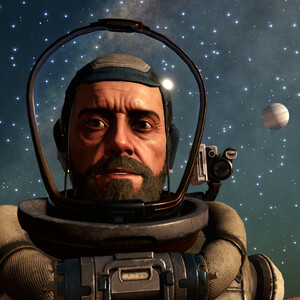My new Sidewinder can jump 41.34 light years!
18 Jan 2024Jeff Hawke
 Commander’s Log, Jan18 3310 – As the engineers said when we left: it is a better Sidewinder you have gotten now. Able to jump 41.34 light years and without heating problems when scooping, the “Little One” rocks.
Commander’s Log, Jan18 3310 – As the engineers said when we left: it is a better Sidewinder you have gotten now. Able to jump 41.34 light years and without heating problems when scooping, the “Little One” rocks.We are back in the Black, and our Exobiology sidekicks, the nimble Sidewinders, are better than ever. We still believe that the engineers can introduce more changes back at base, but what has been achieved in terms of engineering, after our first expeditions, makes the Sideys even better for sampling specimens on the surface of planets. My first test jumping to a series of planets and moons around where the Fleet Carrier The Yellow Star made its recent waypoint confirmed that the Sidewinder has the ideal range when working on Exobiology with the support of a FC. Before we had a 37/38 light years range now we’re rounding 40!
I am aware that there are some differences between the Sidewinder spaceships used by the crew, the engineers want our feedback when we return, and that may help to make them even better. Having such a small vessel able to jump 41.34 light years is always a compromise, so we are aware that we’ve to “drive carefully” to keep them working and able to return to the FC after each tour. After all, the way they are built for making Exobiology viable with a “land anywhere” spaceship makes you feel that you are travelling inside a… tin can.
That is how it felt on this first outing from the FC. As I moved away from the safe harbor and entered Super Cruise, I felt the immense darkness around the ship and that the only thing keeping me safe was a thin metallic sheet protecting me, much like a space blanket. I discovered, though, that the new shielding applied worked fine and even helped to get the hull temperatures within acceptable parameters when scooping, which is one of the dangerous moments for a small ship like the Sidewinder.
Following a suggestion from the engineers, we have also adopted a new routine to scoop fuel from stars. We circle the planet keeping the port side of the vessel towards the star. That allows to keep an eye on the gauges and eyeball the distance to the hot emissions from the surface. I believe you can also fly it with starboard turned to the planet, if that is what suits you best, but my experience scooping fuel from some twenty planets and moons on this outing confirmed that it works. Perfectly, I dare say!
We usually scoop fuel as many times as possible because fuel levels on the Sidewinder are always less than ideal due to the size of the tanks. That is the reason why, although my “Little One” can jump 41.34 light years, we prefer to reduce that range a bit and use an additional tank that doubles capacity. The effective jump range goes down to 39.46 light years, but you’ve enough margin to fly safely around without having "Bitchin' Betty" filling the cockpit with the alarming “low fuel” warning, if you’ve the cockpit warning system active.
If you are curious about the build of my Sidewinder “Little One”, you can check it online, it is no secret. It is not fully engineered, because some of the options, like the Life Support modules, are not available in the Bubble so we will have to check that in the future. As I noted, this new version is a Work In Progress, and we believe there is more to do, especially in terms of thermal resistance. It is like having a conventional family car – for those who know what it was – and trying to make a “hot rod” out of it. In this case more a “exobiology hot rod”.
One thing is sure: it has been a fun project and the billions of credits easily earned from Exobiology because we can land – almost – anywhere, right on top of the specimens we are after, make it worthwhile. That is why we keep at it: I returned to the Fleet Carrier The Yellow Star 200 million of credits richer yesterday!
